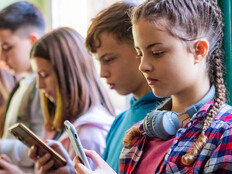Why I Flip-Flopped on the Flipped Classroom
In July 2011, I wrote a blog post called "The Flip: Why I Love It — How I Use It." At the time, I argued that "the flip is only as good as the teacher who performs it," and that it's used successfully if done "in bite-sized chunks."
When I wrote that post, I imagined the flip as a stepping stone to a fully realized inquiry- or project-based learning environment.
Essentially, the flip reverses traditional teaching. Instead of lectures occurring in the classroom and assignments being done at home, the opposite occurs: Lectures are viewed at home by students, via videos or podcasts, and class time is devoted to assignments or projects based on this knowledge. It's unlike traditional homework in that students know we won't spend class time going over the content they've studied at home. Instead, we use that content as a springboard into deeper discussion and activities.
For the next six months, we used the flipped approach sparingly and successfully in my classroom in Canada's Prairie South School Division 210. For example, when studying genetics, I had my students watch a brief video on the basics of DNA, from home, and take notes on what they learned. The next day, they spent class time building models of the DNA double helix, based on the video they'd watched and the theory they'd studied the night before.
But less than a year and a half later, the flip was no longer part of my classroom. Although I didn't disagree with anything I'd written in the earlier post, I had found that the flip didn't produce the transformative learning experience I knew I wanted for my students.
Taking Control
Originally, I stumbled upon the idea of the flip while shifting my classroom to a learner-centered environment. It was one of many techniques we experimented with, but not the one that stuck for us.
Instead, we created a classroom that's best described as an inquiry- and project-based, technology-embedded one — one in which my students take responsibility for their own learning.
As our classroom shifted from teacher- to student-centered, my students began to do the majority of their own research. Sometimes, this means they teach each other. Sometimes, they create a project around the knowledge they are acquiring. Sometimes, they create their own driving questions. Sometimes, they create their own units.
Ultimately, we have realized that three fundamental questions should drive the teaching and learning experience:
- What are you going to learn?
- How are you going to learn it?
- How are you going to show your learning?
As this new way of learning has played out over time, my students have found that they no longer need me to locate or create videos for them. They can find their own resources and direct their own learning.
My goal as a teacher is to help them become independent learners, to give their learning a purpose that is apparent to them (beyond simply passing the unit exam). I prompt them to reflect on their thinking and learning while sharing stories of my own journey as a learner. I help them develop skills, such as finding and evaluating sources and collaborating with their peers.
These days, I'm no longer an information-giver and gatekeeper. Rather, my aim essentially is to work myself out of a job by the time they graduate.








